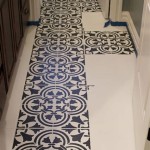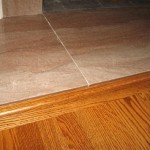Laying Flooring Over Asbestos Tile: A Comprehensive Guide
Asbestos floor tiles, commonly installed in residential and commercial buildings constructed before the 1980s, present a unique challenge when homeowners or property managers consider new flooring installations. While asbestos itself is not a danger unless disturbed and its fibers become airborne, the removal process can be complex, costly, and potentially hazardous. Therefore, laying new flooring over existing asbestos tiles is often considered a viable option. This approach, however, requires careful planning, preparation, and adherence to specific guidelines to ensure safety and compliance with regulations.
This article provides a detailed overview of the considerations and procedures involved in laying new flooring over asbestos tiles. It addresses the key aspects of assessing the existing flooring, preparing the surface, selecting appropriate flooring materials, and implementing safe installation practices. Furthermore, it emphasizes the importance of understanding local regulations and consulting with qualified professionals when dealing with asbestos-containing materials (ACM).
Understanding the Risks and Regulations
Asbestos, a naturally occurring mineral fiber, was widely used in building materials due to its fire-resistant, insulating, and durable properties. In floor tiles, asbestos fibers were typically bound within a matrix of vinyl or asphalt, making them relatively stable when undisturbed. However, when these tiles are broken, sanded, or otherwise damaged, asbestos fibers can be released into the air, posing a health risk through inhalation. Prolonged exposure to asbestos fibers has been linked to serious respiratory illnesses, including asbestosis, lung cancer, and mesothelioma.
Due to these health risks, the use of asbestos has been heavily regulated in many countries. Regulations vary depending on the jurisdiction, but they generally address the handling, removal, and disposal of ACM. Before undertaking any flooring project involving potential asbestos-containing materials, it is crucial to consult with local authorities and environmental agencies to understand the applicable regulations. Some jurisdictions may require professional asbestos testing and abatement before any work can be performed.
It is often recommended to have the existing floor tiles tested by a certified asbestos inspector to confirm the presence of asbestos. This testing typically involves collecting samples of the tiles and analyzing them in a laboratory. The testing results will provide valuable information for making informed decisions regarding the flooring project. Even if the tiles are confirmed to contain asbestos, leaving them undisturbed and covering them with a new layer of flooring might be the preferable and often the most cost-effective approach, provided that the existing floor is in good condition and properly prepared.
Assessing and Preparing the Existing Asbestos Tile Floor
Before laying new flooring, a thorough assessment of the existing asbestos tile floor is essential. This assessment should evaluate the condition of the tiles, the stability of the subfloor, and any potential issues that could compromise the integrity of the new flooring. Key factors to consider include:
Tile Condition: Examine the tiles for any signs of damage, such as cracks, chips, or loose tiles. If the tiles are severely damaged, they may need to be repaired or stabilized before proceeding. Minor cracks can often be filled with patching compound specifically designed for use over asbestos tiles. Loose tiles should be re-adhered using an appropriate adhesive. Avoid breaking or disturbing the tiles during the repair process.
Subfloor Condition: Assess the condition of the subfloor beneath the tiles. A stable and level subfloor is crucial for the success of any flooring installation. If the subfloor is uneven, damaged, or prone to moisture, it may need to be repaired or replaced before proceeding. Addressing subfloor issues early on will help prevent problems such as buckling, warping, or uneven wear of the new flooring.
Moisture Levels: Check the moisture levels in the subfloor. Excessive moisture can lead to mold growth and damage to the new flooring. Use a moisture meter to measure the moisture content of the subfloor. If moisture levels are high, identify and address the source of the moisture before installing the new flooring. This may involve repairing leaks, improving ventilation, or installing a moisture barrier.
Once the assessment is complete, the existing asbestos tile floor needs to be properly prepared. This preparation typically involves cleaning the surface, leveling any imperfections, and applying a suitable underlayment. The following steps are generally recommended:
Cleaning: Thoroughly clean the existing floor tiles to remove any dirt, dust, grease, or other contaminants. Use a mild detergent and water solution, and avoid harsh chemicals or abrasive cleaners that could damage the tiles. Allow the floor to dry completely before proceeding.
Leveling: Level any uneven areas or imperfections in the existing floor. Use a self-leveling compound specifically designed for use over asbestos tiles. Follow the manufacturer's instructions carefully, and ensure that the compound is compatible with the new flooring material. Allow the leveling compound to cure completely before proceeding.
Underlayment: Install an underlayment over the existing floor tiles. The underlayment provides a smooth, stable, and cushioned surface for the new flooring. Choose an underlayment that is compatible with both the existing asbestos tiles and the new flooring material. Some underlayments also provide additional insulation or soundproofing benefits. Consider using a thicker underlayment to further encapsulate the asbestos tiles and minimize the risk of disturbance.
Selecting Appropriate Flooring Materials and Installation Techniques
The choice of flooring material is an important consideration when laying new flooring over asbestos tiles. The selected material should be durable, moisture-resistant, and compatible with the existing floor. Several flooring options are suitable for this application, including:
Luxury Vinyl Plank (LVP): LVP is a popular choice due to its durability, water resistance, and ease of installation. It is also available in a wide variety of styles and colors, making it a versatile option for any room. LVP typically features a click-lock installation system, which allows for a floating floor that does not require adhesive. This is generally preferred when covering asbestos tiles, as it minimizes the risk of disturbing the existing floor.
Laminate Flooring: Laminate flooring is another durable and affordable option. It is also available in a wide range of styles and colors, mimicking the look of hardwood or tile. Like LVP, laminate flooring typically features a click-lock installation system, making it easy to install over existing asbestos tiles. However, laminate flooring is not as water-resistant as LVP, so it is important to address any moisture issues before installation.
Engineered Hardwood: Engineered hardwood flooring is a great option if you want the look of real hardwood. It consists of a layer of hardwood veneer bonded to a plywood or fiberboard core. Engineered hardwood is more dimensionally stable than solid hardwood, making it less susceptible to warping or cupping due to moisture. It can be installed using a variety of methods, including floating, gluing, or nailing. A floating installation is recommended when covering asbestos tiles.
Sheet Vinyl: Sheet vinyl flooring is a seamless, waterproof option that is ideal for bathrooms and kitchens. It is available in a wide variety of patterns and colors, and it is relatively easy to install. Sheet vinyl is typically glued down to the subfloor, but when installing over asbestos tiles, consider using a perimeter-bonded installation method, where the adhesive is only applied around the edges of the room. This minimizes the risk of disturbing the asbestos tiles.
When installing the new flooring, it is essential to follow the manufacturer's instructions carefully. Use appropriate tools and techniques to avoid damaging the existing asbestos tiles. Avoid using power tools that could generate dust, such as saws or grinders. If cutting is necessary, use a sharp utility knife or a scoring tool to minimize dust and debris. Work in a well-ventilated area, and wear appropriate personal protective equipment (PPE), such as a respirator, gloves, and eye protection.
Proper disposal of any waste materials is also important. Any debris generated during the installation process should be carefully collected and disposed of according to local regulations. Contact your local waste management authority for information on proper disposal procedures for asbestos-containing waste.
Key Points Summary
Adherence to Best Practices and Safety Precautions
Throughout the entire process of laying flooring over asbestos tiles, adhering to best practices and implementing strict safety precautions is paramount. This includes not only following the manufacturer’s instructions for the chosen flooring material but also taking steps to minimize any potential disturbance to the existing asbestos tiles.
Importance of Professional Consultation
While this article provides comprehensive information, it is not a substitute for professional advice. Consulting with a certified asbestos inspector and a qualified flooring contractor is highly recommended, especially if you have any concerns about the presence of asbestos or the complexity of the project. Professionals can provide valuable guidance and ensure that the project is completed safely and in compliance with all applicable regulations.
Long-Term Monitoring and Maintenance
After the new flooring is installed, it is important to monitor the floor regularly for any signs of damage or wear. Promptly repair any cracks or imperfections to prevent water damage or further deterioration. Avoid using abrasive cleaners or harsh chemicals that could damage the flooring or the underlying asbestos tiles. With proper care and maintenance, the new flooring can provide a safe and attractive surface for many years to come.

Installing Hardwood Over Asbestos Tiles Homeadvisor

Can I Put A New Floor Over Asbestos Tiles Branch Environmental

How To Install Hardwood Flooring Over Asbestos Tiles 123

Flooring That Can Be Installed Over Asbestos Tile

How To Waterproof A Basement

Asbestos Floor Tiles 101 What To Know About This Old Home Hazard Bob Vila

How Can I Easily Safely And Ly Cover Asbestos Flooring

Can You Lay Tile Over Linoleum Rubi Blog Usa

How Do I Paint Asbestos Flooring Perfectprimer

Asbestos Floor Tile Removal Vinyl Thermoplastic And Bitumin
Related Posts








